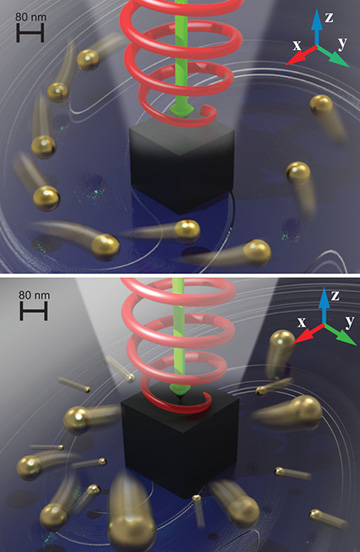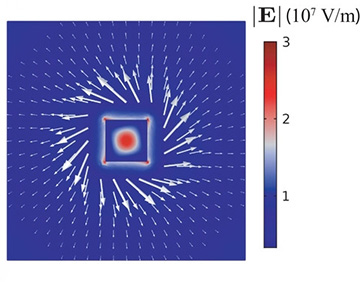
A team of scientists from Russia and Czechia have proposed a scheme that uses a silicon nanocube antenna, suspended gold nanoparticles and incident circularly polarized light to mix fluids (top) and radially sort nanoparticles (bottom) inside microfluidic channels. [Image: Canós Valero et al., Adv. Sci. 2020, 1903049, doi: 10.1002/advs.201903049; CC-BY 4.0]
The tiny domain of microfluidics has opened big horizons in chemistry and pharmaceuticals, allowing creation of “lab on a chip” platforms for experiments and drug development. But as scientists look at processes at ever-smaller length and time scales, the problems of rapidly and efficiently mixing different fluids—in channels far thinner than a human hair—become formidable. That’s made it hard to use these platforms to drill down into some potentially fruitful, high-reaction-rate frontiers of chemical engineering.
Now, in numerical experiments, a team of researchers from Russia and Czechia has proposed a possible solution to the problem: using nanoparticles and the radiation pressure of light to create a “nanomixer” that can rev up otherwise slow diffusion mixing in the channel (Adv. Sci., doi: 10.1002/advs.201903049). The researchers’ calculations suggest that the proposed nanomixer can operate at length scales an order of magnitude smaller than other approaches for mixing on lab-on-chip platforms. And the team believes the system can find use not only in mixing on-chip reagents at very short length and time scales, but also as a system for sorting certain nanoparticles by size.
The mixing problem
The difficulties in mixing different species in a microfluid channel stem largely from basic fluid dynamics. Pushing liquid through an extremely narrow pipe, such as a microfluidic channel, implies laminar, sheet-like flow and a very low Reynolds number. That, in turn, means that viscous forces will tend to dominate, and mixing will take place mainly by diffusion, at super-slow rates.
A number of active mixing approaches have been put on the table for microfluidics, to decrease the so-called mixing length and consequently increase the reaction rates open to experiments. These schemes have included the use of ultrasound and electro- and magnetohydrodynamic systems to shake things up a bit, and thereby more rapidly mix liquids in microfluidic channels.
Laser light, which carries radiation pressure big enough to move micron-scale particles, has also been pressed into service to create localized mixing bowls in microfluidic channels. For example, shaped beams such as Bessel beams—which carry both linear and angular momentum—can be applied directly to create tiny optical vortices that stir around particles in the channel, giving rise to micro-whirlpools that enhance fluid mixing.
Getting smaller and faster
Even these approaches, however, operate at only the scale of optical wavelengths. Ideally, chemists would like to be able to mix fluids locally on chip at even smaller length scales, which would enable experiments at still faster reaction rates.
To get there, the team behind the new research—led by Alexander Shalin of ITMO University, Russia—went to the computer, to model potential mixing schemes that could operate at the nanoscale in a microfluidic channel. Their modeled system draws on the emerging field of all-dielectric nanophotonics. In particular, they focused on the use of so-called Mie resonances to locally enhance and scatter light fields at subwavelength scales around dielectric nanoparticles, in much the same way as plasmonic resonances can boost fields around metallic nanoparticles (see “Meta-Optics with Mie Resonances,” OPN, January 2017).
In the scheme modeled by the Russian–Czech team, a silicon cube around 200 nm on each side is planted at the base of the microfluidic channel, which contains both the reagents to be mixed and a population of suspended, chemically inert gold nanoparticles around 40 nm in radius. A circularly polarized green laser beam is then shone down onto the nanocube.

In the team’s setup, the nanocube acts as an antenna that converts a portion of the spin angular momentum of the incident light into orbital angular momentum in the scattered field, creating an optical vortex. The plot here shows the direction and relative size of the transverse component of the scattered Poynting vector in a numerical experiment. [Image: Canós Valero et al., Adv. Sci. 2020, 1903049, doi: 10.1002/advs.201903049; CC-BY 4.0]
The cube, acting as a dielectric nanoantenna, converts part of the spin angular momentum of the circularly polarized incident light into orbital angular momentum in the scattered light field. The scattered light creates an optical vortex field in the surrounding liquid, the radiation pressure from which nudges the suspended gold nanoparticles along, causing them to swirl within and mix the liquid.
Subwavelength mixing scales
The team’s modeling suggests that the diminutive mixing bowl in this setup would be only a few hundred nanometers in diameter—around half of the illuminating wavelength. That’s an order of magnitude smaller than the length scale achieved when using, for example, a Bessel beam to directly create the same kind of mixing.
The direction of mixing can quickly be reversed by flipping the sense of the circular polarization in the incident light. And, in a bonus, the dielectric cube antenna can also be used as a kind of nanoscale “sorting hat” to separate different-sized gold nanoparticles directly inside the microfluidic chip.
Thus far, these feats have taken place only inside a computer; the team is now looking at ways to realize the proposed concept in physical experiments. Once that’s done, though, the scientists believe that the scheme—which they say can easily be realized using current production processes for microfluidic chips—opens “very exciting perspectives” for microfluidics at very small length and time scales, “such as light‐controlled mixing or even on‐chip directional fluid navigation.”
In addition to researchers at ITMO, the study also included scientists from the Russian Academy of Sciences, the Electrotechnical University and LLC COMSOL, Russia, and the Czech Academy of Sciences, Czechia.
